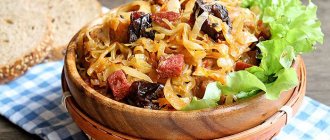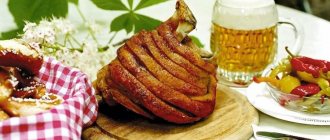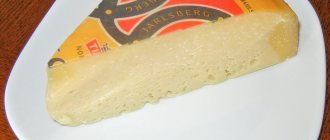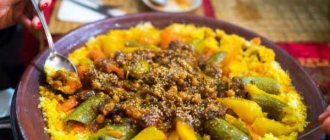The national cuisine of Poland was formed from the colossal diversity of the peoples of the Polish-Lithuanian Commonwealth and the natural resources of the land. The diet is replete with plant ingredients and meat, which are combined either in Oriental or Italian dishes. The diet of medieval Poland was considered plentiful, nutritious, overly spicy, multi-ingredient and not always tasty. How have the gastronomic preferences of Poles changed and what is happening to them now?
General characteristics of the kitchen
Polish cuisine, like culture, was formed under the pressure of regional characteristics and external influences. On the territory of the Polish-Lithuanian Commonwealth (located in part of the territories of modern Poland) lived many peoples who brought their own characteristics to national dishes and drinks. The result is Eastern, Jewish, Ruthenian, French, German, Italian, Jewish culinary influence.
Content:
- General characteristics of the kitchen
- Basic menu ingredients in medieval Poland
- Flavor palette
- National dishes
- Alcohol
The most popular dishes: dumplings, grain porridges, cabbage rolls, dumplings, meat cutlets, meat chops, meat jelly, pork knuckle, cabbage soup, tomato soup, rassolnik, mushroom soup, chicken broth, flaki (offal soup), sea or freshwater fish. Poles love dishes with cabbage and potatoes, pickles, rye bread, cottage cheese, currants, apples and pears. Donuts, gingerbreads, poppy seed rolls and cheesecakes are prepared as dessert.
Vodka accounts for the majority of sales on the alcohol market. The alcoholic liquid is infused with potatoes or cereals. Vodka has replaced drinking honey, which was previously popular, and has become the absolute favorite of the locals. Beer demonstrates another high level of consumption. Locals revere beer traditions, go to pubs and organize alcohol festivals. Wine is significantly inferior to beer and vodka; imported drinks dominate the market.
Coffee appeared in the country only in the 18th century. The drink was common both among artisans and rich peasants. Tea was most often drunk with sugar and a slice of lemon. The first batches of tea were brought from England. In turn, tea came to England through the light hands of Dutch traders. There is also a version that tea was brought by Russian traders in the 19th century during the division of the Polish-Lithuanian Commonwealth. It was during this period that Russian samovars appeared in Polish homes.
A little history
The development of Polish national cuisine began in the 10th century, when the Polans settled on the territory of modern Poland.
The favorable geographical location and climatic conditions contributed to the emergence of products that have become the basis of many dishes of modern cuisine:
- rye and wheat flour;
- cereals;
- domestic animal meat and game;
- eggs;
- honey;
- hemp oil;
- dairy products;
- vegetables and fruits.
Polish kings made their contribution to the formation of traditional cuisine by marrying princesses of neighboring states (Lithuania, Italy, Russia, Hungary, the Czech Republic). They brought their chefs with them, and also invited specialists from France and Italy. It was they who brought a touch of aristocracy to Polish cuisine. At the beginning of the 14th century, Jews began to populate the country en masse, bringing their culinary recipes to the local residents. The Jewish tradition of using goose fat instead of pork fat has taken root and is popular to this day.
There have been tragic moments in the history of the country when part or all of the territory belonged to other states. These events also left their mark on the formation of the kitchen. Many national dishes of Polish cuisine are reminiscent of Russian, Ukrainian, Austrian, and German.
Important! The basis of Polish cuisine is hearty and nutritious dishes using different types of meat, eggs, sour cream, and mushrooms. Poland has gained a reputation as a country of soups, which are even served at the holiday table.
Modern Polish cuisine combines the aristocratic traditions of Western Europe with peasant patriarchal cuisine. She easily accepted the kitchen traditions of other peoples, thanks to which she is distinguished by a huge variety of dishes.
Basic menu ingredients in medieval Poland
The Polish culinary tradition is dominated by fast and slow carbohydrates. Among them are various cereals, pasta and bakery products. The diet of the average citizen necessarily includes plant-based forest products. This is due to the fact that about 30% of the country is covered with forests, and the predominant industry is agriculture. In the diet you can notice an abundance of nuts, various herbs, mushrooms, fruits and vegetables.
The diet was formed due to territorial features. Even the predominance of a certain type of meat on the menu depended on the distribution of a particular animal in the forest area.
The country did not cut down forests for pastures, so there was very little territory left for livestock. The animals were not kept in a barn, but were grazed near their place of residence. First of all, cattle were considered as a valuable source of milk. Pigs and poultry were bred for meat. Hunting for animals living in the forest was also common - from rabbits to roe deer and wild boars. Absolutely all parts of the animal were used for food, even blood and tripe were used. For example, they were used to prepare chernina (black sauce) - a thick soup made from duck/goose blood.
Marine resources are not available in unlimited quantities in Poland. Instead of saltwater fish, the diet is dominated by freshwater fish caught in local lakes, streams, rivers and ponds. Herring was popular among sea fish. It was pickled in salt and transported to the most remote corners of the country. Perishable seafood such as oysters or shrimp were not used. Fish caviar was also not particularly popular.
A special feature of Polish cuisine is a variety of soups and infusions based on meat, grains, plants, fruits or vegetables. The most popular plant products: nettle, dandelion, beets, sorrel, cabbage, cucumbers. Agriculture was centered around food with high nutritional value and a long shelf life during the winter. In the cold season, the diet was enriched with grains, legumes, turnips, kohlrabi, acorns, and nuts. Among the fruits and berries, plums, pears, apples, cherries, cherries, currants, and gooseberries predominated. They were added to baked goods, alcoholic and non-alcoholic drinks such as compote, and jams.
Poles love sour cream (both fresh and sour). It is used instead of traditional Balkan yogurt. Sour cream is used to prepare sauces, marinades, soups, as well as main courses and desserts. The local diet has always included a lot of dairy products. For example, high-protein cottage cheese was used as often as feta cheese in Middle Eastern and Balkan cuisine. In rural areas they drank regular cow's milk, less often goat's milk. Sheep's milk was common in the mountains. The main source of fat was butter, lard, and vegetable oils (linseed/poppyseed). In modern Polish cuisine, rapeseed oil is used predominantly.
The bitter oil (which has undergone the oxidation process) was never thrown away. It was used to prepare sauces, dressings for salads, bread and pancakes.
Useful properties of Polish cuisine
The variety of dishes and the high quality of local products makes Polish cuisine quite healthy.
Of course, it is dominated by fatty and high-calorie dishes, but the skillful use of spices makes them not only incredibly tasty, but also very healthy. Judge for yourself: today the average life expectancy in Poland is 76 years. The Poles themselves are quite critical of their health. But the obesity rate here ranges from 15-17%. Largely due to the fact that the majority of Polish residents are adherents of a healthy diet.
Tatyana Eliseeva chief editor of the Food+ project
Ask a Question
Rating:
0
/10
Votes: 0
Material usefulness 0
Reliability of information 0
Article design 0
Flavor palette
The following flavors predominate in Polish national cuisine:
- salty;
- lightly fermented (sauerkraut, pickles, cottage cheese);
- bread (baked goods and drinks infused with grains);
- moderately spicy (onions, green onions, garlic, mustard, horseradish);
- spicy and herbal (anise, nutmeg, juniper, cumin);
- sour (sauerkraut, salty/sour sour cream);
- sweet and sour (cranberries, apples, other fruits/berries).
The most popular spices are poppy seeds, dill and flaxseeds. Poles dampen the strong, rich flavors a little with sour cream. A similar practice can also be seen in Western Slavic territories.
Traditional Polish pastries
The recipe for making bread requires a special training procedure. Polish rye bread has the maximum degree of usefulness. Flour has certain requirements - coarse grades. Home-made bread is a real source of healthy vitamins. The taste and dietary properties of natural food in Poland are of the highest level. Pastries, sweets, bakery products prepared in the style of traditional national recipes are forever remembered by foreign guests of the Polish country:
- “Kolachiki” (original baked goods with filling, crumbly dough);
- “Mazurek” (large shortbread cake sprinkled with ground sugar);
- “Polish Baba” (rastegai stuffed with dried fruits, butter dough);
- “Favorki” (delicate crispy cakes);
- “Galaretka” (creamy fruit dessert);
- “Makovets” (poppy seed cake);
- “Sernik” (butter pie, cheese filling).
National cuisine of Poland, video:
National dishes
It is important to note that modern Polish cuisine is not much different from medieval cuisine. Potatoes have replaced porridge and grains, and pork and poultry are used instead of game. The daily diet included tomatoes and peppers, the volume of meat consumption increased, but the Poles decided to give up offal. Another important step is the production of cheap sugar from sugar beets.
First meal
Soups are most often served as the only dish for lunch or dinner. They are eaten with black rye bread or whole grain rolls. Poles prepare two types of borscht – white and red. Red is prepared on the basis of beets, and sorcerers (dumplings) are added to the finished dish. White borscht is based on a kvass base. When ready, add finely chopped sausage and several halves of a boiled egg to the white borscht. The taste of the finished dish is slightly reminiscent of pickle.
Rosul is a clear broth made from beef or poultry. Noodles or other pasta are added to the rosul, sprinkled generously with chopped herbs, and served with rye bread. Kapustnyak or cabbage soup is an analogue of Russian cabbage soup. The dish is traditionally served at the Christmas table. Cabbage is prepared from unpressed sauerkraut with brine, meat and herbs. Grochovka is a classic pea soup. Flyaki is a soup made from beef/pork stomach or tripe. Chernina is a soup with the blood and giblets of duck, goose or pig.
Second courses
For the second course, dishes of minced meat are most often served with a side dish in the form of porridge or thermally processed vegetables. Often the whole duck or pork is baked. The food is generously seasoned, horseradish, mustard and various pickles or pickled mushrooms are added.
Bigos is a traditional dish that is a unique symbol of Polish cuisine. This is stewed cabbage with meat. There are many options for preparing bigos. You can use fresh/sauerkraut or a mix of them. You can also vary the type of meat - from game to homemade pork or regular sausage. In addition to meat and cabbage, red wine, tomatoes, wild mushrooms, prunes and various spices/herbs are added to bigos. The finished dish acquires a thick consistency, a sour taste and a rich aroma of smoked meats. Bigos is served hot with a few slices of bread and strong alcohol.
Saltison - boiled chopped pork offal (kidneys, diaphragm, liver, lungs, heart, lard) with salt. Spices, garlic, pepper are added to the offal, mixed, then transferred to large pig intestines or stomach, boiled and baked in the oven. The result is a spicy, burgundy-colored sausage. Saltison is served cold a day after preparation.
Kapytka or dumplings is a dish made from potatoes, salt and flour. Raw or heat-treated potatoes are grated or finely chopped with a knife, then salt and flour are added. Diamonds are formed from the potato mass, boiled in salted water or baked in the oven. Kapytki is served with mushroom or tomato sauce, vegetable stew or sour cream.
Also served as second courses are various types of sausage, dumplings (kolduny), smoked sirloin (polendvitsa) and fish in Polish. Fish in Polish is fried and stewed fish fillet in sauce with a vegetable side dish.
Dessert
In Poland, various sweet pies are prepared, varying the fillings and dough composition. Most often, yeast or yeast sheet dough is used. Popular fillings are apple, cottage cheese, dried fruits, poppy seeds, and nuts. They also make classic gingerbread cookies and donuts. Donuts are filled with wild rose jam.
Poles love regular shortbread cookies with jam or preserves. The dough is rolled into an envelope and jam, honey or low-fat cottage cheese with fruit are placed inside.
Previously, shortbread cookies were served at the Christmas table; now the dessert is prepared in every home and sold both in family street shops and in large hypermarkets.
Best materials of the month
- Coronaviruses: SARS-CoV-2 (COVID-19)
- Antibiotics for the prevention and treatment of COVID-19: how effective are they?
- The most common "office" diseases
- Does vodka kill coronavirus?
- How to stay alive on our roads?
Polish babka is a traditional dessert made from yeast dough. Previously, the dish was served for Easter, since its shape is very similar to the classic Easter cake. The top of the babka is covered with chocolate/cream/fruit glaze. Inside, in addition to yeast dough, there is alcohol, raisins, dried cherries and candied fruits.
Alcohol
The absolute leader is vodka. Every store is stocked with strong alcohol of different varieties. Moreover, alcohol production is carried out even at home. The most famous tincture is bison. It is infused on the stems of bison grass, which bison feed on. The Polish equivalent of whiskey is starka. The alcohol concentration in stark reaches 30-40% vol. The liquid is obtained by aging rye vodka in oak wine barrels. Linden flowers, pear leaves and apples are added to the drink. Fruit spirit liqueurs are also popular.
Beer is a traditional Polish low-alcohol drink. The country is home to several breweries that are known for centuries-old traditions and quality beer (Zywiec, Elbląg, Warka). During the cold season, locals drink heated beer or wine with the addition of honey and aromatic seasonings.
More fresh and relevant information about health on our Telegram channel. Subscribe: https://t.me/foodandhealthru
We will be grateful if you use the buttons:











